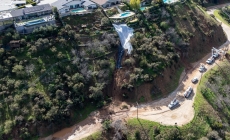-
Have Burmese Pythons Expanded Their Range in Florida? - July 11, 2022
-
A portion of Mulholland Drive, damaged by mudslides in winter storms, reopens - May 26, 2024
-
‘Maybe You Don’t Want to Win’ - May 26, 2024
-
Donald Trump Putting Law Enforcement in Danger: Attorney - May 25, 2024
-
Avoid the waters of these 5 L.A. County beaches this holiday weekend, public health officials say - May 25, 2024
-
Bawdy Comedy ‘Anora’ Wins Palme d’Or at Cannes Film Festival - May 25, 2024
-
Map Shows Heat Wave Zone Spread Into Five New States - May 25, 2024
-
Azusa police arrest suspected slingshot-wielding vandal - May 25, 2024
-
Donald Trump Hammers Judge Ahead of Jury Instructions - May 25, 2024
-
Sometimes U.S. and U.K. Politics Seem in Lock Step. Not This Year. - May 25, 2024
Have Burmese Pythons Expanded Their Range in Florida?
Burmese pythons are large snakes native to parts of Southeast Asia that have now become established in South Florida as a hugely successful invasive species. But has their range in the state expanded over time?
The snakes, which are among the largest in the world, were introduced to Florida in the 1970s and 1980s when thousands of specimens were imported to be sold as exotic pets.
Some of these snakes were released into the wild, either intentionally or accidentally, and eventually began to breed, establishing a population in the state.
They now pose a significant threat to native wildlife given that they prey upon many bird and mammal species, including some that are listed under the U.S. Endangered Species Act. In fact, severe declines in some small mammal populations in Florida have been linked to the invasive pythons.

iStock
What Is the Current Range of the Burmese Python in Florida?
According to the Florida Fish and Wildlife Commission (FWC), the breeding population of Burmese pythons is found in the south of Florida, throughout the Everglades National Park, Southern Glades Wildlife and Environmental Area, and Everglades and Francis S. Taylor Wildlife Management Area, as well as Big Cypress National Preserve.
Pythons have also been spotted in parts of southwest Florida, including Collier-Seminole State Park, Rookery Bay National Estuarine Research Reserve, and adjacent areas.
In addition, recent sightings have included locations in the west towards Naples and further north closer to Lake Okeechobee, for example.
Some Burmese pythons have also been found in the Florida Keys but scientists have yet to confirm that there is a breeding population in the archipelago.
The snakes have been reported in some locations outside of south and southwest Florida, but it is likely that they are escaped or released pets and not part of the breeding population, according to the FWC.
Estimates for the size of the Burmese python population are almost impossible to make because the snakes are so hard to detect, but based on the number that are captured, there are likely tens of thousands in the state, perhaps up to 100,000 or potentially even more.
Has the Range of Burmese Pythons Expanded Over Time in Florida?
According to Bryan Falk, a program analyst with the National Invasive Species Council, it is challenging to estimate the exact geographic distribution of the pythons because they are so hard to find. But it does appear that their range has grown in the state since first being introduced.
“Generally speaking, the areas where pythons occur have expanded over time, but there are exceptions,” Falk told Newsweek.
“For example, there was a cold snap in 2010 that caused many pythons in Florida to die, which may have temporarily caused their range to shrink. This showed how the geographic range of pythons can be constrained by temperature,” he said.
R. Alexander Pyron, a researcher in the Department of Biological Sciences at the George Washington University’s Columbian College of Arts & Sciences, told Newsweek that the southern tip of Florida is a unique environment in the United States because it has a tropical climate with ecoregions officially classified as “rainforest,” “monsoon” and “savanna.”
“These match the native range of the python very closely, which is why it has established there so well,” Pyron said. “So, it appears that the pythons might be expanding within that narrow range of climates—for example, towards Naples or Lake Okeechobee—but not outside of that climate range, farther north up the Florida peninsula.
“I would characterize what is happening with the python’s range in Florida as them becoming more established in the tropical climate zone, but not expanding outside of it.”
Is it possible that the snakes could expand outside of this tropical region? This scenario does not appear to be likely. One 2012 study, for example, found that pythons are incapable of establishing themselves outside of the tropical climate in south Florida, because they can’t digest food, reproduce, or survive the frost.
“Based on our knowledge of snake biology, climate, and the existing models, it is hard to imagine the Burmese python becoming established anywhere else in the continental U.S. outside of the tropical ecoregion in extreme south Florida,” Pyron said.
“They require these tropical temperatures consistently throughout the year, but that kind of environment doesn’t exist anywhere else in the lower 48. Look at it this way: Burmese pythons have not expanded their natural range in China north towards Shanghai or Beijing for the same reason; it is too cold. That is analogous to the situation in the U.S.”
Pyron pointed to a similar situation with boa constrictors, which naturally occur in Mexico within around 100 miles of the U.S. border from Arizona to Texas.
“Yet, boas don’t range into the United States, because the temperatures simply drop off too rapidly for them to survive any farther north,” he said.
However, there are other factors at play which could potentially complicate the picture, according to Falk, who pointed to evidence from the past few years indicating that the Burmese pythons may be adapting to better handle colder temperatures.
“As pythons have expanded their range, they are more often found using tortoise and other animal burrows, which can shield them from cold temperatures,” he said. “Also, there is strong evidence of natural selection in genes responsible for cold tolerance, suggesting the python population in Florida today is better adapted to cold temperatures than it was prior to 2010.”
Source link































